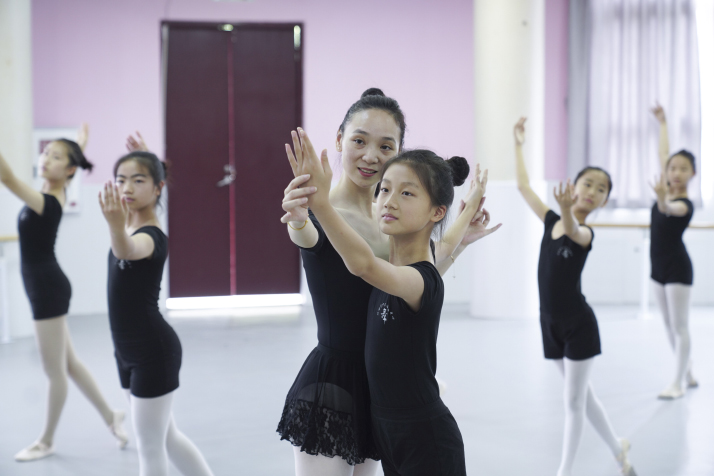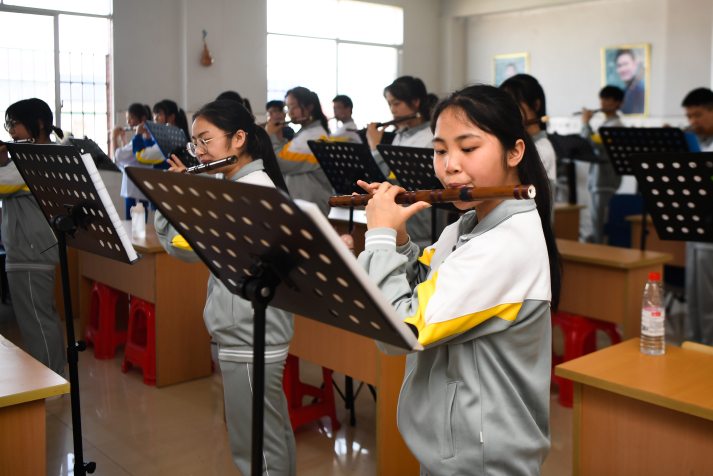| China |
| As off-campus academic tutoring has been reined in, art education gets a leg up | |
|
|
 A teacher with her students at a dancing class in Chongqing on July 18 (XINHUA)
Absorbed by the appreciation of illustration, 11-year-old Zhang Duoduo is one of the children joining their parents at the Bologna Illustrators Exhibition China Tour, which was launched in Beijing in mid-August. Such leisure time was previously rather rare as she used to attend hours of math class on the weekend. After education authorities introduced a new guideline to ease the burden of excessive homework and off-campus tutoring for students in the compulsory education system from primary to middle school in July, curriculum-subject tutoring services of many education companies have come to a full halt. Although math has been taken out of the equation, Zhang has continued participating in after-school painting courses. "I started learning creative art and traditional Chinese painting when I was 5 and have developed a great interest in the skill," Zhang told Beijing Review. According to Selina Yang, Zhang's mother, many parents originally had no intention of sending their children to off-campus institutions to study math, Chinese and English on the weekend as they were only in primary school. However, tutoring enterprises went big on the advertising, leading many adults to worry that their children might miss out on a competitive edge. As a part-time illustrator herself, she views art education as an essential part of learning whether her daughter will choose to pursue it as a major and make a career out of it or not. Following the reining in of off-campus curriculum-subject tutoring, many educational enterprises have unveiled their plans to concentrate on courses in the fields of art and science. New Oriental Education and Technology Group, once centering on English teaching, recently announced its move to off-campus daycare and nursery service training. Another online education startup called Yuanfudao already launched a brand new science education program based on artificial intelligence in late July. In addition, the company is reportedly developing music-related courses for children. In 2020, the authorities issued a set of directives on the expansion of physical and aesthetic education in schools. They further set goals of greatly improving the education syllabi by 2022, and developing diversified and high-quality systems of physical and aesthetic education by 2035. Some regions have initiated pilot programs that include the subject of art in the entrance exam for middle schools earlier this year, a feat expected to be further rolled out by 2022. No longer viewed as a complete distraction from children's studies, art schooling is getting a leg up. A large market With growing spending power and upgraded demands, China's art-loving scene has been rapidly expanding in recent years, with cultural events like exhibitions, drama performances and concerts becoming increasingly popular. Abebe Gasparini, from Italy, studied at Tsinghua University in 2018-19. In an interview with Beijing Review, he said he was caught off guard when he noticed just how knowledgeable many Chinese could be about the history and art of Europe thanks to the frequent museum expos dedicated to Italian art. Many Chinese parents, often art lovers themselves, hold somewhat different views on education—compared to those of the previous generation. For these new-generation parents, training in core school subjects is no longer No.1 on the agenda as they view art education equally significant in the broadening of their kids' horizons. Data released by market research consultancy Qianzhan Industry Research Institute last year showed that China's art training market was worth over 270 billion yuan ($41.7 billion). It projected that this figure could reach nearly 300 billion yuan ($46.4 billion) by 2022. While some students take art courses with the aim of potentially carving out a future career path, many are only eyeing to experience an environment different from that of daily life in school. Aside from the more usual subjects such as painting, singing, dancing and playing an instrument, performing has become a hot commodity in the field of art education. During these courses, children learn how to write scripts, as well as how to create and act out their own performances. Some plays are executed in English, giving them ample opportunity to improve their language skills. QFun Theater, a Beijing-based troupe for children, is one of the most notable domestic theater workshops. According to Wang Nan, one of its founders, the courses on offer do not intend to turn the kids into career performers. "Many of the children have performed their works on global stages. Such courses are supposed to unleash their imagination, help them think independently, work in teams, and provide a vent for them to express emotion," Wang told China Culture Daily.  Students at a middle school in Luxi County, Hunan Province, learn to play the flute on May 22, 2020 (XINHUA)
Teaching by example With the reforms introduced by educational authorities in recent years, art education in public schools, too, has gained some ground. According to the Ministry of Education, the number of educators teaching art subjects in primary and middle schools rose from around 590,000 in 2015 to more than 700,000 in 2019. A total of 20 universities developed collaborative ties with rural schools in 18 provincial-level regions by providing art courses and training local teachers. School facilities for art education have also seen their fair share of upgrades. The ministry further stressed that the after-class services of schools must be extended, and the establishment of clubs for arts, sports, reading and other hobbies is therefore strongly encouraged. For many art instructors, teaching a creative subject involves more than playing games with students. It's all about unleashing their innermost creativity. Zhang Linli, a painting teacher at a primary school in Beijing, told Beijing Review that many students gladly sign up for the paper-cutting courses. The school has also formed a student choir. According to Zhang, students select the courses according to their personal interests. Compared with the after-school art tutoring that their parents pick out for them, courses offered by the school itself can provide children with more choices. "When teaching only aims to improve exam scores, students can easily grow tired of it all. Education is the key to overall development and it is our job to help students discover and develop their individual interests by providing them with more knowledge and encouraging them to express their views," she said. Not another hotspot Although art education has been more widely embraced by the public, art tutoring institutions may not prove as popular as curriculum-subject tutoring companies used to be given the latest policies focus on reducing the burden of students in all respects. Many art courses, especially dancing and instrument playing, are also hard to be given and taken online, leaving little room for tutoring platforms to expand their businesses. In terms of public schools, art education still has a long way to go. "The 'art gap' between schools in different regions remains. Once art is included in the official exams, many students may only focus on improving their scores. That deviates from the original intention of improving the quality of art education and the all-inclusive capability of a school's student body. In this sense, the authorities still need to seek a balance," Tang Wenjuan, founder of a Beijing-based culture company, concluded. (Print Edition Title: More Than Art) Copyedited by Elsbeth van Paridon Comments to lixiaoyang@bjreview.com |
|
||||||||||||||||||||||||||||||
|
